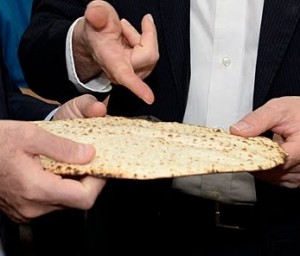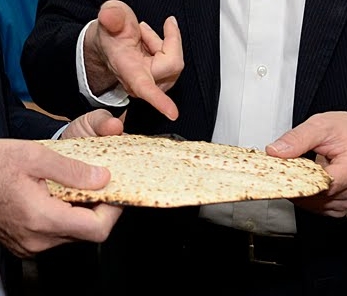
These divrei Torah were adapted from the hashkafa portion of Rabbi Yissocher Frand’s Commuter Chavrusah Tapes on the weekly portion: #1331 Should Women Bentch HaGomel? Good Shabbos!
The following is both a beautiful comment on Parshas Tzav and on the Hagaddah.
The first of the four Mah Nishtana questions is “…on all other nights we eat chametz or matzah, tonight only matzah“. Most of us have been saying this since we were five years old. Maybe when we were five, we did not pause to notice the following very glaring inference:
The traditional way to translate “she’bechol haleilos anu ochloim chametz u’matzah” is that on all other nights we can eat either Chametz or Matzah. In truth, that is not what the questions says. Literally, the question states that every night of the year, we eat chametz and matzah. Now in fact, rarely, at any given meal, do we eat both chametz and matzah together. So, it seems that it would have been more appropriate to phrase this question differently.
In fact, it is not necessary to go very far to come up with a more apt way of expressing this “either/or” dichotomy between chametz and matzah. The fourth question states “…on all other nights we are seated bein yoshvin u’bein mesubin (whether sitting or reclining) tonight we are all reclining.” If the author of the Hagaddah is smart enough to figure out how to contrast two alternative scenarios with the expression “bein yoshvin u’bein mesubin” why did he not utilize a similar formula and say “shebechol haleilos anu ochlim bein chametz u’bein matzah,” which would mean “either/or”?
The Binyon Ariel was the Rav in Amsterdam. He says that the first question is indeed precisely articulated as stated that “on all other occasions we eat chametz and matzah together”. How so?
The Binyon Ariel explains something unique about the Korban Todah (Thanksgiving Offering), which is in our parsha. The Korban Todah is a very unique offering. Not only do you bring an animal offering on the Mizbayach (Altar), but together with the Korban Todah, the person needs to bring “Lachmei Todah” (breads of the Thanksgiving Offering). Lachmei Todah are very peculiar because they include both leavened and unleavened loaves!
The Binyon Ariel explains that the first question in the Hagaddah (based on the Mishna in Arvei Pesachim) is referring to the fact that normally when we bring a Korban Todah, we do so with chametz and with matzah together. This question is not referring to what we eat on Seder night in our time. This question is referring to the Korban Pesach, which is very similar to a Korban Todah. Unlike the normal Korban Shlamim which may be eaten for two days and one night, the Korban Todah is only eaten for one day and the following night (i.e. – it must be consumed by the following morning). A Korban Pesach is like that as well. Furthermore, just like a Korban Todah needs to be accompanied with bread, so too a Korban Pesach needs to be accompanied by bread (“It shall be eaten upon matzaoh and marror” (Shemos 12:8).
The author of the Hagaddah is asking why on this night are we bringing this unique kind of Thanksgiving Offering that is eaten only with unleavened bread and not also with leavened bread? This is how the Binyon Ariel interprets the first question of the Mah Nishtana.
Rabbi Buchspan from Miami Florida wanted to explain the symbolism of the fact that the regular Korban Todah includes both chametz and matzah and the Korban Pesach only includes matzah.
Rabbi Buchspan quotes an interesting insight from Rav Samson Raphael Hirsch in Sefer VaYikra on the parsha of Korban Todah. Rav Hirsch writes that matzah represents nature in its crudest form, before human involvement and innovation. What is matzah? Flour and water. It does not get more basic than that. There is very little human innovation. You put the flour in the water, you bake it, v’nomar amen.
On the other hand, chametz is an example of man’s manipulation of the natural elements, where human ingenuity yields a far more advanced and sophisticated product than the original ingredients. When you take flour and water and you add yeast and other ingredients, then instead of getting a thin little matzah that sometimes tastes not much better than cardboard, you get a geshmake challah that is a symbol of human involvement and the human ability to make something so much superior to a basic nature-based product.
Rabbi Buchspan writes that when the four individuals who are required to offer a Korban Todah (those who travel across a desert, those who travel across the sea, the seriously ill who are healed, and those who are freed from imprisonment – Brochos 54b) bring their Thanksgiving Offering, they acknowledge that there were two elements that saved them. Number one, the Hand of G-d saved them, with minimal if any human involvement. That is symbolized by the matzah. But whenever a person is saved in any one of these situations, there is also human involvement. When a person is sick and he needs an operation, it is not the doctor or the surgeon that heals, it is the Ribono shel Olam that heals. But on the other hand, healing requires hishtadlus (human effort). You need to find the right doctor. You need to go to the doctor. You need to make decisions regarding your care and follow the recommended medical protocol. A person’s healing certainly requires personal involvement as well as that of the Almighty. We are not Christian Scientists who claim “The Almighty made me sick. He will make me well.” We do great hishtadlus in seeking competent medical treatment, which is a very legitimate thing to do.
Likewise, if a person is crossing a desert or travelling on the high seas, he needs to make effort on his own to return to civilization. He cannot just rely on the Ribono shel Olam to miraculously pluck him from his dangerous situation. If a person is on a sinking ship, he needs to get into the life boat. He cannot say “If G-d wants to save me, He will save me miraculously.” So the four individuals who need to offer thanks must all offer a dual acknowledgement – an acknowledgement of the Yad Hashem, symbolized by the matzah (which is lacking in human involvement) and an acknowledgement of his own successful effort to return safely home or to regain his health, symbolized by the chometz (which requires human involvement).
However, the Korban Pesach is different. This is the miracle of the Ribono shel Olam acting on His Own. “You shall not leave the door of your house until morning” (Shemos 12:22). The Angel of Death was roaming the streets of Mitzrayim. What were the Jews supposed to do? They were commanded to do nothing, to act with total passivity. Everything will be taken care of by the Ribono shel Olam. That is why the Korban Pesach—which is a form of the Korban Todah, which normally involves human participation—was brought with only matzah, symbolizing the lack of human involvement in the deliverance from Mitzrayim.
Transcribed by David Twersky; Jerusalem [email protected]
Edited by Dovid Hoffman; Baltimore, MD [email protected]
This week’s write-up is adapted from the hashkafa portion of Rabbi Yissochar Frand’s Commuter Chavrusah Series on the weekly Torah portion. A listing of the halachic portions for Parshas Tzav is provided below:
- #004 When to Make the Bracha of HaGomel#004
- #092 Non-Kosher Products: The Dilemma of the Jewish Merchant
- #499 Davening Quietly
- #543 Birchas HaGomel, Airplane Travel and Other Issues
- #587 Afikomen Revisited
- #631 Periodontal Problems
- #675 Going Away For Pesach and Bedikas Chometz
- #719 The Importance of Shabbos Clothes
- #763 Eating Matzo When Ill
- #851 Proper Attire for Davening
- #895 Birchas HaGomel – More Insights
- #1331 Should Women Bentch HaGomel?
- #1375 Thoughts on the Hagaddah
- #1419 Bedikas Chametz – Should You Shut the Lights Out? What To DO With The Leftover Chametz in the Garbage Can?
- #1463 Pesach Shailos During the Corona Pandemic
A complete catalogue can be ordered from the Yad Yechiel Institute, PO Box 511, Owings Mills MD 21117-0511. Call (410) 358-0416 or e-mail [email protected] or visit http://www.yadyechiel.org/ for further information.


